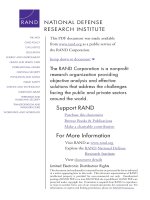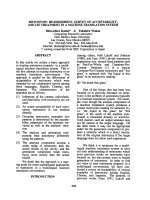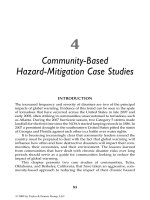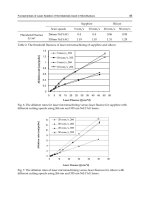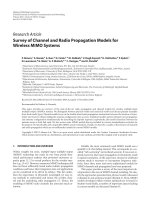Lecture Principle of inventory and material management - Lecture 4: Production Planning System (Continued)
Bạn đang xem bản rút gọn của tài liệu. Xem và tải ngay bản đầy đủ của tài liệu tại đây (522.06 KB, 44 trang )
Lecture 4
Production Planning System (Continued)
Books
•
Introduction to Materials Management, Sixth Edition, J. R. Tony Arnold, P.E., CFPIM, CIRM, Fleming
College, Emeritus, Stephen N. Chapman, Ph.D., CFPIM, North Carolina State University, Lloyd M.
Clive, P.E., CFPIM, Fleming College
•
Operations Management for Competitive Advantage, 11th Edition, by Chase, Jacobs, and Aquilano, 2005,
N.Y.: McGrawHill/Irwin.
Objectives
•
•
•
•
Production planning hierarchy
Inventory cost
Type of inventory
Production settings
Production Planning Hierarchy
LongRange Capacity Planning
Aggregate Planning
Master Production Scheduling
Production Planning and Control Systems
Pond Draining
Systems
Push
Systems
Pull
Systems
Focusing on
Bottlenecks
Production Planning Horizons
LongRange Capacity Planning
LongRange
(years)
Aggregate Planning
MediumRange
(618 months)
Master Production Scheduling
ShortRange
(weeks)
Production Planning and Control Systems
VeryShortRange
(hours days)
Pond Draining
Systems
Push
Systems
Pull
Systems
Focusing on
Bottlenecks
Production Planning: Units of Measure
LongRange Capacity Planning
Entire
Product Line
Aggregate Planning
Product
Family
Master Production Scheduling
Specific
Product Model
Production Planning and Control Systems
Labor, Materials,
Machines
Pond Draining
Systems
Push
Systems
Pull
Systems
Focusing on
Bottlenecks
Aggregate Planning
Why Aggregate Planning Is Necessary
•
•
•
•
Fully load facilities and minimize overloading and
underloading
Make sure enough capacity available to satisfy
expected demand
Plan for the orderly and systematic change of
production capacity to meet the peaks and valleys of
expected customer demand
Get the most output for the amount of resources
available
Inputs
•
•
•
A forecast of aggregate demand covering the selected
planning horizon (618 months)
The alternative means available to adjust short to
mediumterm capacity, to what extent each alternative
could impact capacity and the related costs
The current status of the system in terms of workforce
level, inventory level and production rate
Outputs
•
•
A production plan: aggregate decisions for each
period in the planning horizon about
– workforce level
– inventory level
– production rate
Projected costs if the production plan was
implemented
MediumTerm Capacity Adjustments
•
•
•
Workforce level
– Hire or layoff fulltime workers
– Hire or layoff parttime workers
– Hire or layoff contract workers
Utilization of the work force
– Overtime
– Idle time (undertime)
– Reduce hours worked
. . . more
MediumTerm Capacity Adjustments
•
•
Inventory level
– Finished goods inventory
– Backorders/lost sales
Subcontract
Approaches
•
•
•
•
Informal or TrialandError Approach
Mathematically Optimal Approaches
– Linear Programming
– Linear Decision Rules
Computer Search
Heuristics
Pure Strategies for the Informal Approach
•
•
Matching Demand
Level Capacity
– Buffering with inventory
– Buffering with backlog
– Buffering with overtime or subcontracting
Matching Demand Strategy
•
•
•
•
Capacity (Production) in each time period is varied to
exactly match the forecasted aggregate demand in that
time period
Capacity is varied by changing the workforce level
Finishedgoods inventories are minimal
Labor and materials costs tend to be high due to the
frequent changes
Developing and Evaluating the Matching Production Plan
•
•
•
Production rate is dictated by the forecasted aggregate
demand
Convert the forecasted aggregate demand into the
required workforce level using production time
information
The primary costs of this strategy are the costs of
changing workforce levels from period to period, i.e.,
hirings and layoffs
Level Capacity Strategy
•
•
Capacity (production rate) is held level (constant) over
the planning horizon
The difference between the constant production rate
and the demand rate is made up (buffered) by
inventory, backlog, overtime, parttime labor and/or
subcontracting
Developing and Evaluating the Level Production Plan
•
•
•
Assume that the amount produced each period is
constant, no hirings or layoffs
The gap between the amount planned to be produced
and the forecasted demand is filled with either
inventory or backorders, i.e., no overtime, no idle
time, no subcontracting
. . . more
Developing and Evaluating the Level Production Plan
•
•
The primary costs of this strategy are inventory
carrying and backlogging costs
Periodending inventories or backlogs are determined
using the inventory balance equation:
EIt = EIt1 + (Pt Dt )
Aggregate Plans for Services
•
•
•
For standardized services, aggregate planning may be
simpler than in systems that produce products
For customized services,
– there may be difficulty in specifying the nature and
extent of services to be performed for each
customer
– customer may be an integral part of the production
system
Absence of finishedgoods inventories as a buffer
between system capacity and customer demand
Preemptive Tactics
•
There may be ways to manage the extremes of
demand:
– Discount prices during the valleys.... have a sale
– Peakload pricing during the highs .... electric
utilities, Nucor
Time Horizon in Production Planning
Static Vs. Dynamic Environments
•
•
•
Models used for production planning are either static
or dynamic
Static
– Constant through time
– Assume same plan acceptable in each period for
the foreseeable future
Dynamic
– Explicitly consider changes in demand and
resource availability to determine what should be
done through time over a planning horizon
– Require stochastic data
21
–
The Role of Inventory
•
•
•
•
•
•
Inventory consists of physical items moving through the
production system
Originates with shipment of raw material and parts from the
supplier
Ends with delivery of the finished products to the customer
Costs of storing inventory accounts for a substantial
proportion of manufacturing cost
– Often 20% or more
Optimal level of inventory
– Allows production operations to continue smoothly
A common control measure is Inventory Turnover
22
Inventory Turnover
•
•
•
•
•
The ratio of annual cost of goods sold to average
inventory investment.
It indicates how many times a year the inventory
is sold.
Higher the ratio, the better, because it implies
more efficient use of resources.
Higher the profit margin and longer the
manufacturing lead time, the lower the inventory
turns.
Example: Supermarkets (low profit margins) have
a fairly high turnover rate
23
Inventory Definitions and Decisions
•
•
•
Batch or order size, Q
– Batch size is the number of units released to the shop floor
to be produced
Reorder point, r
– Specifies the timing for placing a new order
Inventory Position
Inventory Position = Inventory On Hand + On Order – Backorders
•
•
Units on order
– Have been ordered but not yet arrived
Backorders
– Items promised to customers but not yet shipped
24
– New units are shipped out to cancel backorders
Types of Inventory
•
•
•
•
Raw Materials
– Essential to the production process
– Often kept in large quantities on site
Finished Goods
– Completed products awaiting shipment to customers
WorkinProcess (WIP)
– Batches of semi finished products currently in production
– Batches of parts from time of release until finished goods
status
Pipeline
– Goods in transit between facilities
– Raw materials being delivered to the plant
– Finished goods being shipped to warehouse or customer
25


